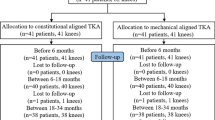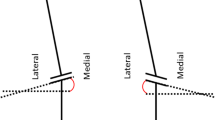Abstract
Purpose
In total knee arthroplasty (TKA), knee phenotypes including joint line obliquity are of interest regarding surgical realignment strategies. The hypothesis of this study is that better clinical results, including decreased postoperative knee pain, will be observed for patients with a restored knee phenotype.
Methods
A retrospective analysis was performed on prospective data, including 1078 primary osteoarthritic knees in 936 patients. The male:female ratio was 780:298, mean age at surgery was 71.3 years ± 8.0. International Knee Society Scores and standardized long-leg radiographs (LLR) were collected preoperatively and at 2 years follow-up after TKA. Patients were categorized using the Coronal Plane Alignment of the Knee (CPAK) classification including the lateral distal femoral angle (LDFA) and medial proximal tibial angle (MPTA) measured on LLR by a single observer, allowing knee phenotypes to be categorized considering the arithmetic hip–knee–ankle (aHKA) angle (MPTA-LDFA) as measure of constitutional alignment, and joint line obliquity (JLO) (MPTA + LDFA). Clinical results were compared between patients with surgically restored preoperative constitutional knee phenotype to patients without restored constitutional knee phenotypes. Descriptive data analysis such as means, standard deviations and ranges were performed. T tests for independent samples were performed to compare group differences. Comparisons of categorical data were performed using the χ2 test. Significance was set at p < 0.05.
Results
A third of patients (33.4%) had constitutional knee varus with apex distal JLO. 63.5% of patients had preoperative apex distal JLO. Postoperatively, 57.8% of patients had a neutral HKA (− 2° to 2°) and a neutral JLO (− 3° and 3°), with only 18% of patients with restored constitutional knee phenotype. Of these patients, statistically less postoperative pain was observed in patients where apex distal JLO was restored compared to non-restored apex distal JLO (pain score 46.7 vs. 44.6; p = 0.02) without clinical relevance. Other categories of restored JLO or arithmetic HKA angle were not associated with improved outcomes.
Conclusion
This study showed that performing mechanical alignment for primary TKA resulted in most cases in a change of the preoperative knee phenotype. These results emphasize the relevance of considering joint line obliquity to better understand preoperative knee deformity and better restore knee phenotypes with a more personalized realignment strategy to potentially improve TKA postoperative results.
Level of evidence
III.



Similar content being viewed by others
References
Abdel MP, Ollivier M, Parratte S, Trousdale RT, Berry DJ, Pagnano MW (2018) Effect of postoperative mechanical axis alignment on survival and functional outcomes of modern total knee arthroplasties with cement: a concise follow-up at 20 years. J Bone Joint Surg Am 100:472–478
An VVG, Twiggs J, Leie M, Fritsch BA (2019) Kinematic alignment is bone and soft tissue preserving compared to mechanical alignment in total knee arthroplasty. Knee 26:466–476
Bellemans J, Colyn W, Vandenneucker H, Victor J (2012) The Chitranjan Ranawat award: is neutral mechanical alignment normal for all patients? The concept of constitutional varus. Clin Orthop Relat Res 470:45–53
Berend ME, Ritter MA, Meding JB, Faris PM, Keating EM, Redelman R, Faris GW, Davis KE (2004) Tibial component failure mechanisms in total knee arthroplasty. Clin Orthop Relat Res 428:26–34
Blakeney W, Beaulieu Y, Kiss M-O, Rivière C, Vendittoli P-A (2019) Less gap imbalance with restricted kinematic alignment than with mechanically aligned total knee arthroplasty: simulations on 3-D bone models created from CT-scans. Acta Orthop 90:602–609
Blakeney W, Clément J, Desmeules F, Hagemeister N, Rivière C, Vendittoli P-A (2019) Kinematic alignment in total knee arthroplasty better reproduces normal gait than mechanical alignment. Knee Surg Sports Traumatol Arthrosc 27:1410–1417
Boonen B, Kerens B, Schotanus MGM, Emans P, Jong B, Kort NP (2016) Inter-observer reliability of measurements performed on digital long-leg standing radiographs and assessment of validity compared to 3D CT-scan. Knee 23:20–24
Brouwer RW, Jakma TSC, Brouwer KH, Verhaar JAN (2007) Pitfalls in determining knee alignment: a radiographic cadaver study. J Knee Surg 20:210–215
Churches T, Naylor J, Harris IA (2017) Arthroplasty Clinical Outcomes Registry National (ACORN) Annual Report, 2016. Sydney: Whitlam Orthopaedic Research Centre. http://www.acornregistry.org/images/Acorn-Annual-Report-2016-v12.pdf.
Cooke D, Scudamore A, Li J, Wyss U, Bryant T, Costigan P (1997) Axial lower-limb alignment: comparison of knee geometry in normal volunteers and osteoarthritis patients. Osteoarthritis Cartilage 5:39–47
Dossett HG, Estrada NA, Swartz GJ, LeFevre GW, Kwasman BG (2014) A randomised controlled trial of kinematically and mechanically aligned total knee replacements: two-year clinical results. Bone Joint J 96-B:907–913
Evans JT, Walker RW, Evans JP, Blom AW, Sayers A, Whitehouse MR (2019) How long does a knee replacement last? A systematic review and meta-analysis of case series and national registry reports with more than 15 years of follow-up. Lancet Lond Engl 393:655–663
Gbejuade HO, White P, Hassaballa M, Porteous AJ, Robinson JR, Murray JR (2014) Do long leg supine CT scanograms correlate with weight-bearing full-length radiographs to measure lower limb coronal alignment? Knee 21:549–552
Giesinger JM, Hamilton DF, Jost B, Behrend H, Giesinger K (2015) WOMAC, EQ-5D and knee society score thresholds for treatment success after total knee arthroplasty. J Arthroplasty 30:2154–2158
Hirschmann MT, Hess S, Behrend H, Amsler F, Leclercq V, Moser LB (2019) Phenotyping of hip-knee-ankle angle in young non-osteoarthritic knees provides better understanding of native alignment variability. Knee Surg Sports Traumatol Arthrosc 27:1378–1384
Hirschmann MT, Konala P, Amsler F, Iranpour F, Friederich NF, Cobb JP (2011) The position and orientation of total knee replacement components: a comparison of conventional radiographs, transverse 2D-CT slices and 3D-CT reconstruction. J Bone Joint Surg Br 93:629–633
Hirschmann MT, Moser LB, Amsler F, Behrend H, Leclercq V, Hess S (2019) Phenotyping the knee in young non-osteoarthritic knees shows a wide distribution of femoral and tibial coronal alignment. Knee Surg Sports Traumatol Arthrosc 27:1385–1393
Hirschmann MT, Moser LB, Amsler F, Behrend H, Leclerq V, Hess S (2019) Functional knee phenotypes: a novel classification for phenotyping the coronal lower limb alignment based on the native alignment in young non-osteoarthritic patients. Knee Surg Sports Traumatol Arthrosc 27:1394–1402
Insall JN, Dorr LD, Scott RD, Scott WN (1989) Rationale of the Knee Society clinical rating system. Clin Orthop Relat Res 248:13–14
Jabalameli M, Moghimi J, Yeganeh A, Nojomi M (2015) Parameters of lower extremities alignment view in Iranian adult population. Acta Med Iran 53:293–296
Lazennec JY, Chometon Q, Folinais D, Robbins CB, Pour AE (2017) Are advanced three-dimensional imaging studies always needed to measure the coronal knee alignment of the lower extremity? Int Orthop 41:917–924
Lee WC, Kwan YH, Chong HC, Yeo SJ (2017) The minimal clinically important difference for Knee Society Clinical Rating System after total knee arthroplasty for primary osteoarthritis. Knee Surg Sports Traumatol Arthrosc 25:3354–3359
Longstaff LM, Sloan K, Stamp N, Scaddan M, Beaver R (2009) Good alignment after total knee arthroplasty leads to faster rehabilitation and better function. J Arthroplasty 24:570–578
Lonner JH, Laird MT, Stuchin SA (1996) Effect of rotation and knee flexion on radiographic alignment in total knee arthroplasties. Clin Orthop Relat Res 331:102–106
MacDessi SJ, Griffiths-Jones W, Chen DB, Griffiths-Jones S, Wood JA, Diwan AD, Harris IA (2020) Restoring the constitutional alignment with a restrictive kinematic protocol improves quantitative soft-tissue balance in total knee arthroplasty: a randomized controlled trial. Bone Joint J 102-B:117–124
MacDessi SJ, Griffiths-Jones W, Harris IA, Bellemans J, Chen DB (2021) Coronal plane alignment of the knee (CPAK) classification. Bone Joint J 103-B:329–337
MacDessi SJ, Griffiths-Jones W, Harris IA, Bellemans J, Chen DB (2020) The arithmetic HKA (aHKA) predicts the constitutional alignment of the arthritic knee compared to the normal contralateral knee: a matched-pairs radiographic study. Bone Joint Open 1:339–345
Magnussen RA, Weppe F, Demey G, Servien E, Lustig S (2011) Residual varus alignment does not compromise results of TKAs in patients with preoperative varus. Clin Orthop Relat Res 469:3443–3450
Maltenfort M, Díaz-Ledezma C (2017) Statistics in brief: minimum clinically important difference-availability of reliable estimates. Clin Orthop Relat Res 475:933–946
McEwen PJ, Dlaska CE, Jovanovic IA, Doma K, Brandon BJ (2020) Computer-assisted kinematic and mechanical axis total knee arthroplasty: a prospective randomized controlled trial of bilateral simultaneous surgery. J Arthroplasty 35:443–450
Nam D, Nunley RM, Barrack RL (2014) Patient dissatisfaction following total knee replacement: a growing concern? Bone Joint J 96-B:96–100
Nishida K, Matsumoto T, Takayama K, Ishida K, Nakano N, Matsushita T, Kuroda R, Kurosaka M (2017) Remaining mild varus limb alignment leads to better clinical outcome in total knee arthroplasty for varus osteoarthritis. Knee Surg Sports Traumatol Arthrosc 25:3488–3494
Oussedik S, Abdel MP, Victor J, Pagnano MW, Haddad FS (2020) Alignment in total knee arthroplasty. Bone Joint J 102-B:276–279
Paley D, Tetsworth K (1992) Mechanical axis deviation of the lower limbs. Preoperative planning of uniapical angular deformities of the tibia or femur. Clin Orthop Relat Res 280:48–64
Rivière C, Iranpour F, Auvinet E, Howell S, Vendittoli P-A, Cobb J, Parratte S (2017) Alignment options for total knee arthroplasty: a systematic review. Orthop Traumatol Surg Res 103:1047–1056
Ro DH, Kim J-K, Lee DW, Lee J, Han H-S, Lee MC (2019) Residual varus alignment after total knee arthroplasty increases knee adduction moment without improving patient function: a propensity score-matched cohort study. Knee 26:737–744
Sappey-Marinier E, Batailler C, Swan J, Malatray M, Cheze L, Servien E, Lustig S (2020) Primary osteoarthritic knees have more varus coronal alignment of the femur compared to young non-arthritic knees in a large cohort study. Knee Surg Sports Traumatol Arthrosc. https://doi.org/10.1007/s00167-020-06083-5
Schiffner E, Wild M, Regenbrecht B, Schek A, Hakimi M, Thelen S, Jungbluth P, Schneppendahl J (2019) Neutral or natural? Functional impact of the coronal alignment in total knee arthroplasty. J Knee Surg 32:820–824
Sorin G, Pasquier G, Drumez E, Arnould A, Migaud H, Putman S (2016) Reproducibility of digital measurements of lower-limb deformity on plain radiographs and agreement with CT measurements. Orthop Traumatol Surg Res 102:423–428
Vanlommel L, Vanlommel J, Claes S, Bellemans J (2013) Slight undercorrection following total knee arthroplasty results in superior clinical outcomes in varus knees. Knee Surg Sports Traumatol Arthrosc 21:2325–2330
Funding
No funding for this study
Author information
Authors and Affiliations
Corresponding author
Ethics declarations
Conflict of interest
Prof. Sébastien Lustig has performed consultancy work for Medacta, Heraeus, Corin, Amplitude, Groupe Lépine, Depuy Synthes, Smith & Nephew, Stryker. Prof. Sébastien Lustig receives institutional research support from Corin and Amplitude. Prof. Sébastien Lustig is a board member of KSSTA, Maitrise Orthopédique and JBJS american. The other authors declare that they have no conflicts of interest.
Ethical approval
The French advisory committee on health research data processing (Comité Consultatif sur le Traitement de l’Information en matière de Recherche dans le domaine de la Santé [CCTIRS]) approved this study on the 24th January 2012 and then 9 March 2015 (approval #11-681). All procedures performed were in accordance with the ethical standards of the institutional and/or national research committee and with the 1964 Declaration of Helsinki and its later amendments or comparable ethical standards.
Additional information
Publisher's Note
Springer Nature remains neutral with regard to jurisdictional claims in published maps and institutional affiliations.
Rights and permissions
About this article
Cite this article
Sappey-Marinier, E., Batailler, C., Swan, J. et al. Mechanical alignment for primary TKA may change both knee phenotype and joint line obliquity without influencing clinical outcomes: a study comparing restored and unrestored joint line obliquity. Knee Surg Sports Traumatol Arthrosc 30, 2806–2814 (2022). https://doi.org/10.1007/s00167-021-06674-w
Received:
Accepted:
Published:
Issue Date:
DOI: https://doi.org/10.1007/s00167-021-06674-w




